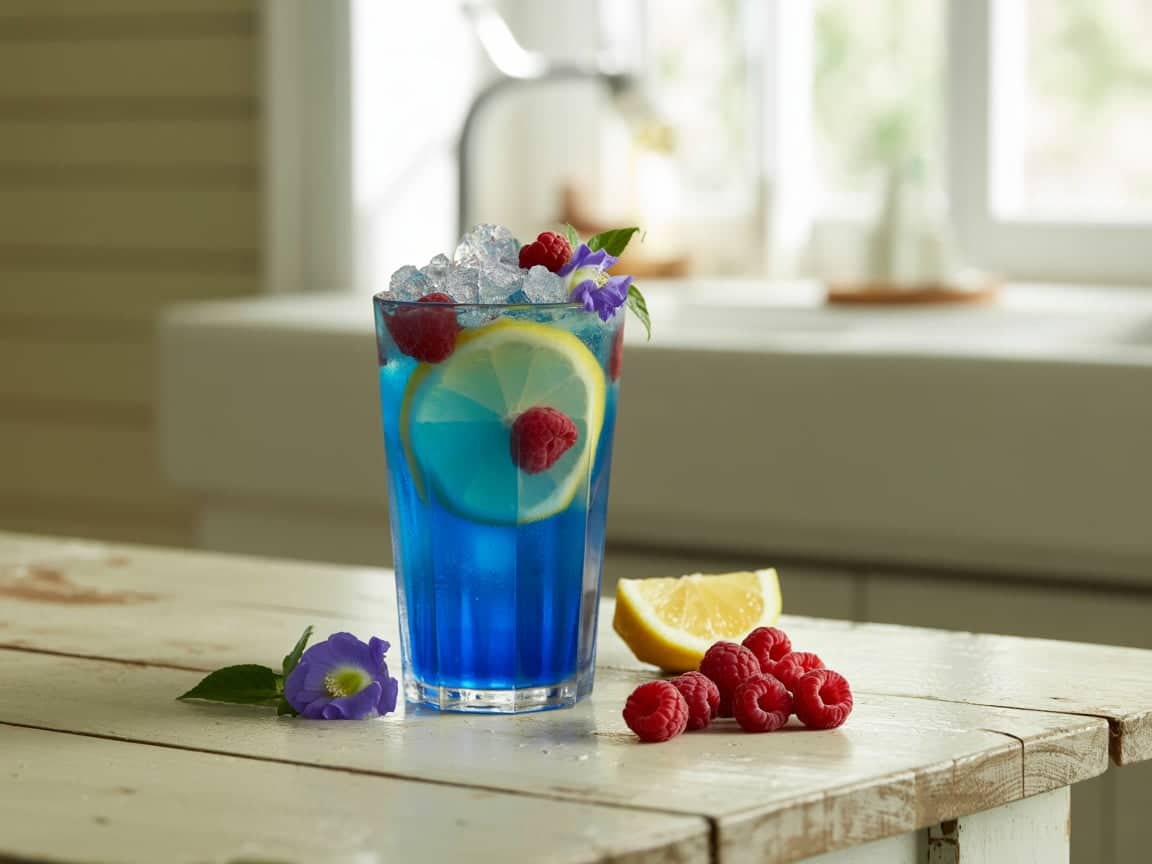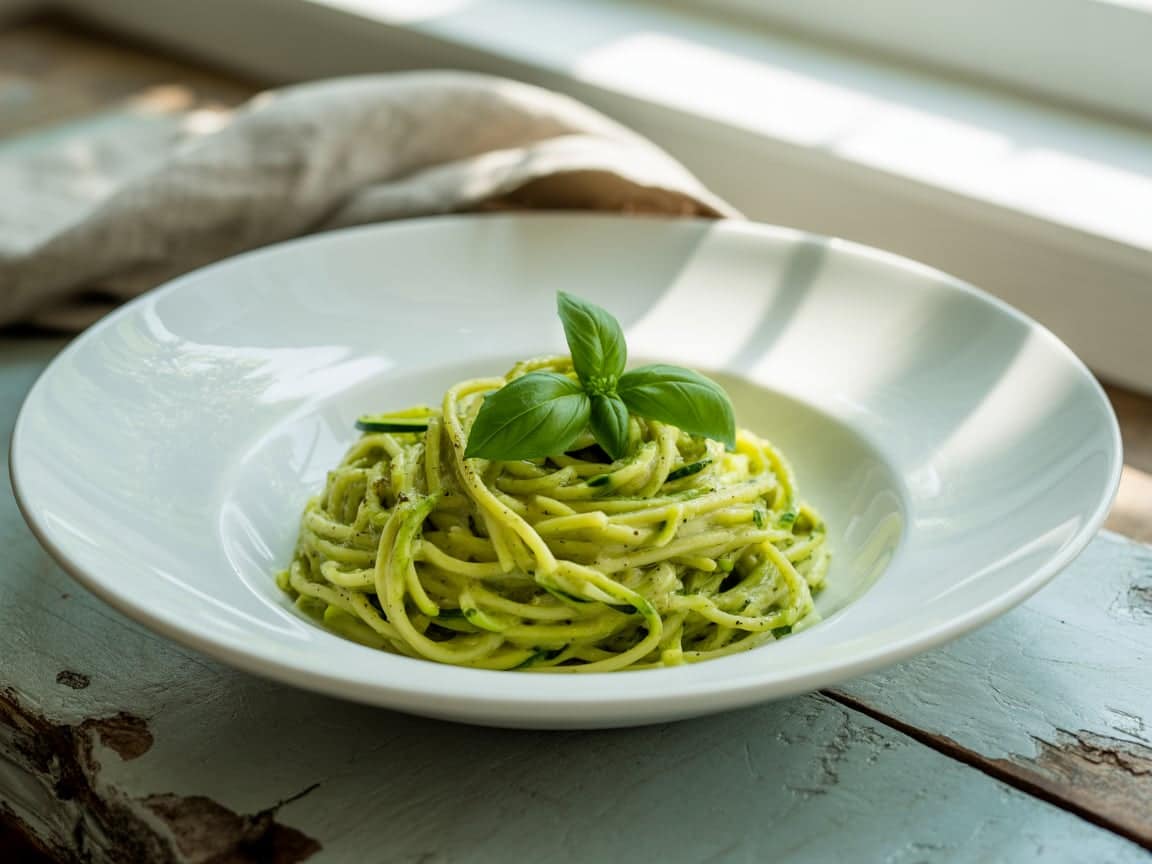Red pepper coulis is that silky-smooth, flavor-packed red sauce you’ve probably seen drizzled artfully on gourmet plates. But it’s not just a chef’s secret anymore. Whether you’re looking to jazz up weeknight chicken or impress guests at dinner parties, red pepper coulis is the kitchen staple you didn’t know you needed. In this article, you’ll learn exactly what red pepper coulis is, how it’s different from other sauces like compote or capsicum coulis, how to make it from scratch, and — most importantly — what to pair it with.
We’ll also explore how to store it, what spices pair best, and how this sauce fits into global cuisine. To top it off, we’ll answer some of the most common questions about red pepper coulis. Ready to sauce things up? Let’s get into it.
Learn more about Honey Ginger Dressing if you love bold, homemade flavors that elevate your meals naturally.
Table of Contents
Introduction to Red Pepper Coulis
What is Red Pepper Coulis?
Red pepper coulis is a smooth, vibrant sauce made primarily from roasted red bell peppers. The term “coulis” comes from French cuisine and originally referred to a strained purée of fruits or vegetables. Unlike chunky salsa or thick tomato-based sauces, coulis is blended until velvety smooth, delivering deep flavor and an elegant texture.
This sauce typically includes roasted red peppers, olive oil, garlic, salt, and sometimes a splash of vinegar or citrus juice. It’s the perfect combination of sweet, smoky, and tangy — depending on how it’s prepared.
Origins and Culinary Significance
The concept of coulis originates from French haute cuisine, where sauces are more than just condiments; they’re critical to the identity of a dish. In fine dining, red pepper coulis is often used as a base or artistic garnish, adding color and complexity. But its use isn’t limited to upscale restaurants anymore — it’s finding its place in home kitchens, thanks to its versatility and ease of preparation.
The popularity of plant-based dishes and Mediterranean-style eating has helped red pepper coulis rise in relevance. With just a few whole-food ingredients, it meets the mark for clean eating while delivering chef-level flavor.
Why It’s Gaining Popularity in Modern Kitchens
Home cooks and food bloggers are turning to red pepper coulis for several reasons:
- It’s a low-calorie flavor booster, perfect for health-conscious recipes.
- It’s plant-based and dairy-free, making it ideal for vegan diets.
- It pairs with nearly everything: meats, veggies, grains, even breakfast eggs.
- It stores well and can be made in large batches.
Thanks to social media food trends and the growing popularity of meal prepping, sauces like red pepper coulis are becoming a go-to hack for quick, delicious meals.
Looking for inspiration? Try Brussel Sprouts and Ham Quiche — it pairs beautifully with a spoonful of red pepper coulis for a gourmet finish.
Red Pepper Coulis vs Other Pepper-Based Sauces
Understanding how red pepper coulis stacks up against other pepper-based sauces helps clarify when and how to use it. From pepper compotes to capsicum purées, there’s a lot of crossover — but also clear distinctions in texture, preparation, and usage.
Coulis vs Compote: Key Differences Explained
One of the most common questions is: How do you make red pepper compote, and how is it different from coulis?
A red pepper compote is typically chunky and slow-cooked with added sugar or vinegar for a sweet-and-savory effect. It’s thicker, sometimes resembling chutney or relish. Compote often includes other ingredients like onions, dried fruits, or even herbs to give it complexity.
In contrast, red pepper coulis is smooth and emulsified, often without sweeteners unless you’re going for a sweeter variation. It’s typically blended until silky and strained for a refined finish. While compotes are cooked longer and reduced, coulis gets its flavor mostly from roasting and blending.
| Feature | Red Pepper Coulis | Red Pepper Compote |
|---|---|---|
| Texture | Silky & smooth | Chunky & textured |
| Preparation | Roasted & blended | Cooked & reduced |
| Taste Profile | Savory, smoky, fresh | Sweet, tangy, rich |
| Typical Use | Sauce base, garnish | Spread, condiment |
Red Pepper Coulis vs Roasted Pepper Sauce
Both use roasted red peppers, but roasted pepper sauces often include ingredients like tomatoes, heavy cream, or broth, giving them a soupier, heavier feel. These sauces are more likely to be used in hearty dishes like pasta bakes or casseroles.
Red pepper coulis is simpler, focusing on the purity of the pepper itself. Its minimal ingredients make it a lighter, fresher option — perfect for topping grilled meats or dressing up a vegetarian dish without overpowering the main elements.
Capsicum Coulis: A Fancy Cousin or the Same Thing?
What is capsicum coulis, and is it just a fancier name?
Yes — “capsicum” is simply the botanical name for the pepper family. In countries like Australia or the UK, “capsicum coulis” is often used interchangeably with red pepper coulis. The only difference may lie in the regional pepper varieties used, which can slightly alter the taste or color.
So whether it’s called red pepper coulis, capsicum coulis, or roasted bell pepper purée, they all fall under the same family — a smooth, blended, flavor-forward sauce made with roasted peppers.
Check out Steak Chimichurri Dense Bean Salad Recipe to see how layered sauces like coulis can elevate protein-packed meals.
How to Make the Perfect Red Pepper Coulis
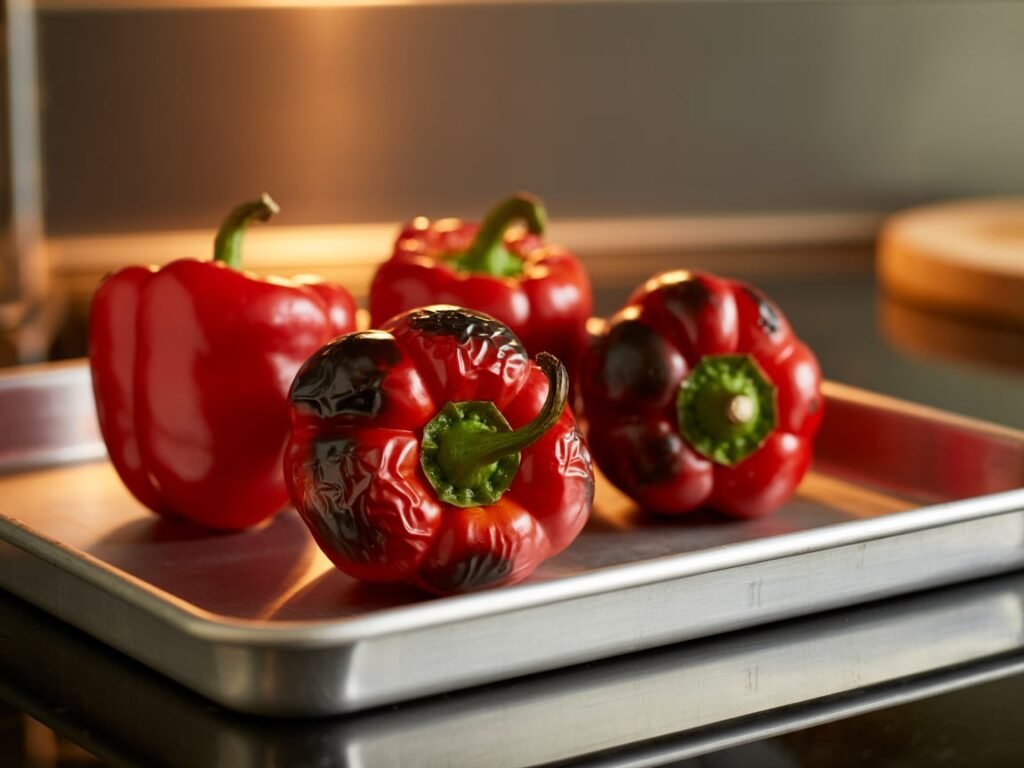
Creating red pepper coulis at home is incredibly rewarding — and easier than you might think. With just a handful of ingredients and a blender, you can whip up a gourmet-worthy sauce that enhances almost any dish. In this section, we’ll walk you through the classic recipe, flavor variations, and pro tips to get restaurant-quality results every time.
Classic Red Pepper Coulis Recipe
Here’s a simple base recipe that delivers bold flavor and a velvety-smooth texture.
Ingredients
- 3 large red bell peppers (roasted)
- 1 garlic clove (roasted or sautéed)
- 2 tablespoons olive oil
- 1 teaspoon balsamic or red wine vinegar
- Salt and pepper to taste
- Optional: a pinch of smoked paprika or chili flakes
Instructions
- Roast the red peppers: Preheat your oven to 425°F (220°C). Slice peppers in half, remove seeds, and place them skin-side up on a baking sheet. Roast for 25–30 minutes until charred and soft.
- Steam and peel: Transfer hot peppers to a bowl, cover with plastic wrap or a lid, and let steam for 10 minutes. Peel off the skins once cooled.
- Blend: Add peeled peppers, garlic, olive oil, vinegar, salt, and any spices to a blender. Blend until completely smooth.
- Strain (optional): For a silky restaurant-style finish, strain through a fine mesh sieve.
- Adjust: Taste and adjust seasoning as needed.
This red pepper coulis recipe yields about 1 cup and can be stored in the fridge for up to 5 days.
Optional Variations: Smoky, Spicy, or Creamy
Want to customize your coulis? Here are a few tasty twists:
- Smoky: Add ½ teaspoon of smoked paprika or use fire-roasted peppers from a jar.
- Spicy: Toss in a roasted jalapeño or a pinch of cayenne pepper.
- Creamy: Blend in 1–2 tablespoons of Greek yogurt or cashew cream for a mellow, rich version.
These tweaks let you tailor the sauce to different types of dishes — smoky for BBQ meats, spicy for tacos, and creamy for vegetarian bowls.
Tips for Roasting and Blending Peppers Like a Pro
- Roast evenly: Cut peppers into flat sections for even roasting and less charring.
- Don’t skip the steaming step: It loosens the skins and makes peeling effortless.
- Use a high-speed blender: It ensures a smoother consistency, especially if you’re skipping the straining step.
- Balance the acid: Don’t go overboard with vinegar — you want brightness, not sourness.
- Taste test: Your peppers may vary in sweetness, so always adjust salt and acid before serving.
Don’t miss our Southwest Dense Bean Salad — it pairs beautifully with a spicy variation of red pepper coulis for a southwest flavor bomb.
Ingredients Deep Dive and Health Benefits
Red pepper coulis may be simple, but its ingredients are nutritional powerhouses. In this section, we’ll break down the core ingredients used in the sauce, explore their individual health benefits, and explain why this condiment isn’t just tasty — it’s also great for your body.
Core Ingredients: Peppers, Garlic, Olive Oil, and Vinegar
Red Bell Peppers
The heart of any red pepper coulis is, of course, roasted red bell peppers. These vibrant veggies are:
- High in Vitamin C — more than twice the daily requirement per serving.
- Packed with antioxidants like beta-carotene and lycopene.
- Naturally sweet when roasted, adding flavor without added sugar.
Garlic
Garlic isn’t just for depth of flavor. It:
- Supports heart health and can help lower cholesterol.
- Contains allicin, a compound known for its antimicrobial properties.
- Boosts immune response with regular use.
Olive Oil
A high-quality extra virgin olive oil is more than a fat — it’s a foundation of Mediterranean nutrition.
- Rich in monounsaturated fats that support heart health.
- Contains powerful polyphenols that reduce inflammation.
- Helps the body absorb fat-soluble vitamins from the peppers.
Vinegar or Citrus
Acid is essential for brightness and balance. Depending on the type used:
- Balsamic vinegar adds a touch of sweetness.
- Red wine vinegar offers tanginess without overpowering.
- Lemon juice brings a fresh, zesty flavor and a boost of Vitamin C.
Each of these ingredients plays a crucial role in building flavor while contributing to the sauce’s impressive health profile.
Nutritional Value of Red Bell Peppers
Let’s take a quick look at what makes red bell peppers the nutritional MVP in this sauce:
| Nutrient | Amount per 1 medium pepper | % Daily Value |
|---|---|---|
| Vitamin C | 152 mg | 169% |
| Vitamin A | 3726 IU | 75% |
| Fiber | 2.5 g | 10% |
| Calories | 31 | — |
They’re low in calories, high in water, and naturally sweet — a win for any dietary lifestyle.
Is Red Pepper Coulis Healthy? Here’s What Experts Say
Yes, red pepper coulis is a nutrient-dense, low-calorie, and heart-friendly sauce. It’s perfect for:
- Clean eating: No added sugars, thickeners, or preservatives.
- Plant-based diets: 100% vegan and naturally gluten-free.
- Weight management: Low in calories but big on flavor, helping you avoid high-fat dressings or cream sauces.
Nutritionists often recommend incorporating more peppers into your diet, and coulis is a delicious, creative way to do it.
Discover great ideas like Liver Flush Juice Recipe if you’re looking to pack more nutrients into your daily routine.
Print
Red Pepper Coulis
Red pepper coulis adds bold flavor to any meal. Discover how to make, store, and use this vibrant sauce in under 5 minutes.
- Total Time: 40 minutes
- Yield: 1 cup 1x
Ingredients
¼ cup extra virgin olive oil
1 cup chopped white onion
1 clove garlic chopped
16 oz roasted red bell pepper drained
1 pinch kosher salt
1 Tbsp heavy cream
2 tsp balsamic vinegar
Instructions
Heat 1 Tablespoon of the olive oil in a skillet over high heat. Add the onion and garlic and cook, tossing regularly, until softened and fragrant. Transfer to a food processor.
Add the roasted peppers, salt, cream, and remaining olive oil to the onion-garlic mixture in the food processor. Process until smooth. Transfer mixture to a saucepan.
Add the balsamic vinegar to the coulis and simmer (*see Notes) 10 minutes. Remove from the heat. Yields ~1-½ cups (12 ounces) sauce.
Notes
Drizzle over meat, veggies, pasta, or use as a dip.
Refrigerate up to 5 days or freeze up to 3 months
- Prep Time: 10 minutes
- Cook Time: 30 minutes
Nutrition
- Serving Size: 1 cup
- Calories: 58kcal
Culinary Uses of Red Pepper Coulis
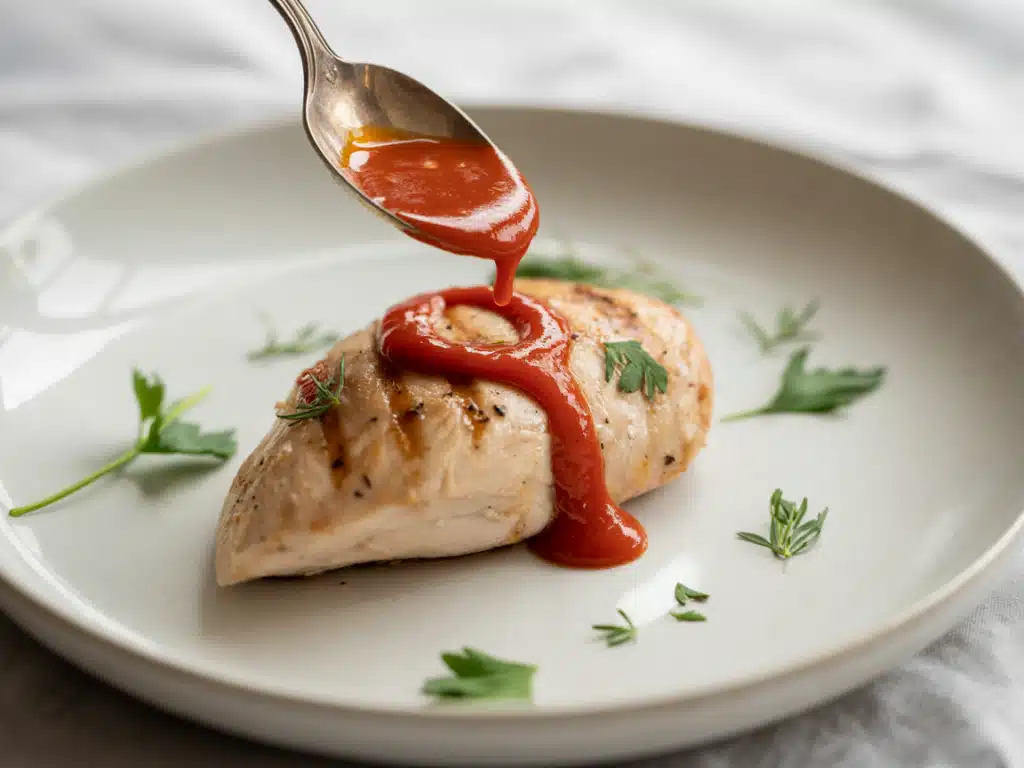
Red pepper coulis isn’t just a pretty drizzle—it’s a culinary chameleon. Whether you’re cooking meat, prepping vegetarian meals, or assembling a quick lunch, this vibrant sauce adds color, moisture, and bold flavor without overpowering your ingredients. Here’s how to get the most out of your batch.
As a Base for Entrees and Pasta Dishes
If you’re tired of heavy cream-based sauces or bland tomato pastes, red pepper coulis is the solution. It serves as a flavorful base for:
- Grain bowls and pasta: Toss it with spaghetti, couscous, or farro for a light, peppery twist.
- Baked dishes: Use it under lasagna layers, in casseroles, or even as the base for baked fish.
- Stuffed vegetables: Spoon it into roasted eggplants, zucchini boats, or bell peppers to amp up flavor.
Because it’s smooth and blends well, red pepper coulis can also be used in creamy-style sauces by adding yogurt, tahini, or cashew cream.
As a Drizzle Over Grilled Meat, Fish, or Vegetables
Red pepper coulis really shines when it’s used as a finishing drizzle. Think of it as the final touch that makes your meal look and taste restaurant-ready.
Great Pairings Include:
- Grilled chicken or steak – Adds a bright, smoky-sweet note without overpowering.
- Roasted or grilled salmon – The acidity and sweetness contrast beautifully with fatty fish.
- Charred vegetables – Cauliflower, asparagus, or roasted carrots soak up the sauce’s deep flavor.
- Scrambled eggs or omelets – Skip the ketchup and elevate your breakfast game.
The best part? It makes basic dishes look gourmet with almost no extra effort.
Creative Uses: Sandwich Spread, Dip, or Pizza Sauce
Red pepper coulis is more versatile than you might expect:
- As a sandwich spread – Slather it onto burgers, wraps, or grilled cheese for a kick of color and taste.
- As a dip – Serve it chilled with pita, chips, or raw veggies as a light alternative to hummus or ranch.
- As a pizza sauce – Use it instead of tomato sauce for white pizzas, veggie flatbreads, or Mediterranean pies.
Its sweet-savory profile makes it adaptable for both hot and cold dishes.
Check out Natural Zepbound Recipe if you’re exploring wholesome, low-guilt additions to your kitchen rotation.
Real-Life Tip
Hosting a dinner party? Use red pepper coulis as a plate garnish. Simply spoon a swirl onto the plate before placing your main dish on top — it makes even a weeknight dinner feel like fine dining.
Storing and Preserving Red Pepper Coulis
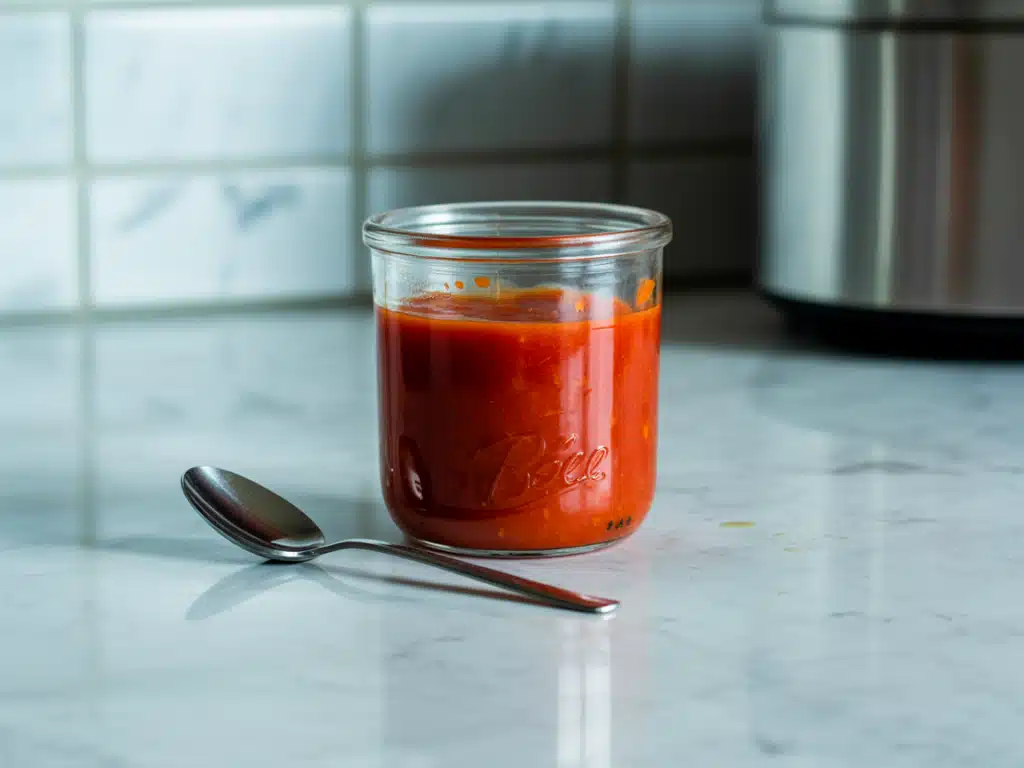
Red pepper coulis is not just flavorful—it’s also super convenient to make ahead. Whether you’re meal prepping for the week or saving leftovers from a dinner party, knowing how to store it properly is essential to preserving both flavor and texture.
Short-Term Storage: Refrigeration Guidelines
Once prepared, red pepper coulis should be cooled to room temperature before storing. Here’s how to keep it fresh for daily use:
- Use an airtight container – Mason jars or glass containers with tight lids are ideal.
- Refrigerate immediately – Keep at or below 40°F (4°C).
- Shelf life – It will stay fresh for up to 5 days in the refrigerator.
Pro tip: Pour a thin layer of olive oil on top before sealing. It creates a barrier against air, helping extend freshness and preventing oxidation.
Freezing Tips and Shelf Life
Want to store red pepper coulis for longer? Freezing is a fantastic option, and it won’t sacrifice much in terms of flavor or texture.
- Portion and freeze – Use silicone ice cube trays to freeze in 1–2 tablespoon servings. Once solid, transfer cubes to a freezer bag.
- Label and date – Mark with the prep date and use within 3 months for best quality.
- Thawing – Thaw in the fridge overnight or microwave a cube on low in a pinch. Stir well before using.
Freezing works especially well for meal preppers and busy families—just grab a cube when you need it!
How to Preserve Flavor During Storage
Even though red pepper coulis freezes well, keeping the taste vibrant takes a few precautions:
- Don’t over-blend herbs or garlic if you’re planning to freeze. These can develop bitter notes over time.
- Avoid cream-based variations when freezing. Dairy can separate and create a grainy texture upon thawing.
- Add acid fresh — If you’re using lemon juice or vinegar, consider stirring it in just before serving rather than before freezing to keep the brightness intact.
Learn more about ABC Fruit Juice for another vibrant, health-boosting staple you can store and enjoy anytime.
Advanced Cooking Tips and Flavor Pairings
You’ve mastered the basics of red pepper coulis — now it’s time to level up. In this part, we’ll go over expert tricks to tweak the flavor, texture, and versatility of your coulis. Plus, you’ll learn which herbs, spices, and acids pair best to bring out the sauce’s full potential.
Spice Pairings: Cumin, Smoked Paprika, Chili
Red pepper coulis has a naturally sweet, earthy flavor, making it an ideal canvas for spice experimentation.
Best spices to complement red pepper coulis:
- Cumin: Adds a warm, nutty depth perfect for Mediterranean and Middle Eastern dishes.
- Smoked paprika: Enhances the natural smokiness of roasted peppers and intensifies color.
- Chili flakes or cayenne: Bring the heat — ideal if you’re pairing coulis with grilled meats or Mexican flavors.
- Black pepper or white pepper: Adds complexity without overwhelming the sauce.
Pro tip: Toast spices in the olive oil before blending for an infused flavor that elevates the entire sauce.
Acid Balance: Lemon Juice vs Balsamic Vinegar
Acid plays a crucial role in balancing the sweetness of roasted peppers. Choosing the right one depends on your dish:
| Acid | Flavor Profile | Best For |
|---|---|---|
| Lemon Juice | Bright, fresh | Seafood, salads, dips |
| Red Wine Vinegar | Tangy, sharp | Pasta, sandwiches |
| Balsamic Vinegar | Sweet, complex | Glazes, grilled meats |
| Apple Cider Vinegar | Mild, fruity | Grain bowls, veggie wraps |
If your coulis tastes dull or overly sweet, add a small splash of acid and retaste. The goal is to strike a balance — not overwhelm.
Texture Control: Smooth or Chunky for Best Results?
The traditional coulis texture is silky-smooth, but that doesn’t mean you can’t break the rules for certain dishes.
Smooth coulis works best for:
- Drizzles over plated dishes
- Pasta sauces
- Sandwich spreads
Chunkier blends (skip straining) are ideal for:
- Rustic meals like grain bowls or grilled veggies
- Dips or spreads where texture adds dimension
- Hearty toppings for grilled meats or toast
Blending tips:
- Use a high-speed blender for ultra-smooth results.
- Add warm water or broth to thin if needed — but go slow.
- For chunkier texture, pulse in short bursts and skip the strainer.
Looking for more real food enhancements? Try Himalayan Salt Mouth Rinse Recipe — a surprising DIY health support using everyday kitchen items.
Red Pepper Coulis in Global Cuisine
Red pepper coulis might have French roots, but its reach goes far beyond European kitchens. Thanks to its flexibility, this vibrant sauce has found a home in cuisines across the globe. In this part, we’ll explore how different cultures use red pepper coulis or similar variants, and how you can bring international flair into your own kitchen.
French Cuisine: Classic Culinary Applications
In France, coulis is all about refinement. Red pepper coulis often appears in:
- Appetizers: As a base for terrines, mousse, or seafood starters.
- Main courses: Paired with fish (like cod or salmon), duck breast, or ratatouille.
- Elegant plating: Swirled under proteins or alongside stacked vegetables for visual appeal.
French chefs prioritize texture and balance. Expect coulis to be velvety, slightly acidic, and often strained for a flawless finish.
Mediterranean Dishes That Shine with Coulis
In Mediterranean cooking, red pepper coulis plays a more rustic, robust role:
- Grilled meats & lamb kebabs – Often served with pepper-based sauces resembling coulis.
- Flatbreads & pitas – Used as a spread or base, especially in Greek or Turkish cuisine.
- Roasted vegetables & eggplant dishes – Adds depth and contrast.
Mediterranean versions may include ingredients like olive tapenade, feta, or fresh herbs like parsley or mint for brightness.
How Chefs Use Coulis in Fusion Recipes
Modern chefs love red pepper coulis for its adaptability in fusion cuisine. It blends seamlessly with flavors from Asia, the Americas, and beyond:
- Asian Fusion: Combine red pepper coulis with soy sauce, ginger, or sesame oil to create sauces for grilled tofu or rice bowls.
- Mexican Influence: Add chili peppers, cumin, or lime juice for a bold taco topping or enchilada base.
- American Comfort Dishes: Drizzle over mac and cheese, burgers, or even scrambled eggs to add gourmet flair.
What’s exciting is how easily you can experiment at home. Red pepper coulis acts like a base paint—you choose the color with spices and herbs.
Want more global twists? Discover Japanese Mounjaro Recipe for a dose of international inspiration in your kitchen.
FAQs About Red Pepper Coulis
To wrap up your culinary journey into red pepper coulis, let’s address the most frequently asked questions. These cover everything from how it’s used to how it compares with similar sauces. Whether you’re a beginner or a foodie experimenting with flavors, these answers will help clarify any lingering doubts.
What do you do with red pepper coulis?
Red pepper coulis is incredibly versatile. You can:
Drizzle it over grilled chicken, steak, or fish.
Use it as a vibrant base for pasta and grain bowls.
Spread it on sandwiches, wraps, or burgers.
Serve it as a dipping sauce for roasted veggies or pita chips.
Plate it elegantly under appetizers or entrées for a restaurant-style presentation.
It’s your secret weapon for transforming everyday dishes into gourmet meals.
How do you make red pepper compote?
Unlike coulis, red pepper compote is a chunky, slow-cooked condiment. Here’s a simple method:
Ingredients:
2 red bell peppers (diced)
1 small onion (sliced)
1 tbsp olive oil
1 tbsp brown sugar
1 tbsp vinegar (balsamic or apple cider)
Instructions:
Sauté onions in olive oil until soft.
Add peppers, sugar, and vinegar.
Simmer over low heat for 30–40 minutes until thickened.
Cool and store.
Compote is sweeter and chunkier than coulis, making it ideal for cheese boards or as a savory-sweet burger topping.
Are coulis cooked?
Yes — but it depends on the ingredients. In red pepper coulis:
The peppers are roasted or cooked beforehand to enhance flavor and softness.
Other ingredients like garlic may also be roasted or sautéed.
After blending, the coulis is usually not cooked further, though it can be gently warmed before serving.
So yes, coulis is partially cooked to develop flavor, but it’s not simmered or boiled like other sauces.
What is capsicum coulis?
Capsicum coulis is the same as red pepper coulis, just using a different name for the pepper. In regions like Australia or the UK, “capsicum” refers to bell peppers. So a capsicum coulis is a smooth sauce made from roasted capsicums — typically red ones — blended with oil, vinegar, and spices.
The flavor, preparation, and use are identical. It’s just a regional variation in terminology.
Conclusion: Elevate Everyday Meals with Red Pepper Coulis
Red pepper coulis proves that a few simple ingredients — when prepared right — can transform how you cook. This sauce isn’t just vibrant in color; it’s bold in flavor, loaded with nutrients, and endlessly adaptable. Whether you’re looking to impress dinner guests, meal prep for the week, or just bring life to an otherwise plain dish, red pepper coulis is a must-have in your culinary arsenal.
From breakfast eggs to grilled seafood, pasta, and even pizza, it works across cuisines and dietary styles. Plus, it’s easy to store, batch cook, and customize to your taste — spicy, smoky, creamy, or tangy.
Want more vibrant flavors like this? Don’t miss our Zobo Drink Recipe — a naturally colorful and nutrient-packed beverage that complements plant-based meals perfectly.


